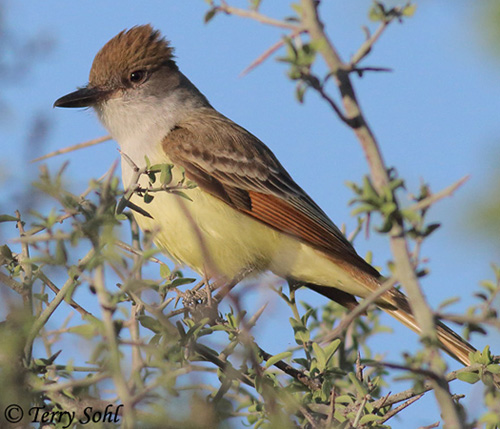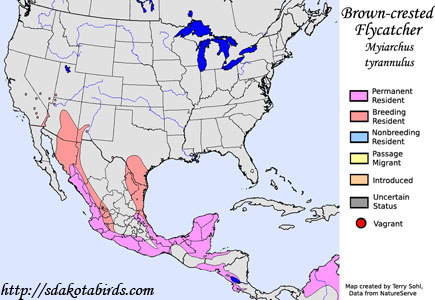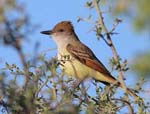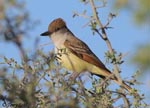Brown-crested Flycatcher
Myiarchus tyrannulus
| Length: 8.75 | Wingspan: 13 inches | Seasonality: Non-resident in South Dakota |
| ID Keys: Lemon-yellow belly, gray breast and neck, brownish-gray face and neck, rufous on tail and wing primaries | ||
 The
Brown-crested Flycatcher is one of several confusing, similar-looking
flycatcher species with obvious crests and yellow on their bellies.
Parts of the Brown-crested Flycatcher's range overlap with the similar
Dusky-capped Flycatcher, the
Ash-throated Flycatcher, and
the Great Crested Flycatcher.
The Brown-crested is the largest of the group, but size differences are
minimal and aren't a reliable field mark. The songs are different and
can be used to help differentiate the species.
The
Brown-crested Flycatcher is one of several confusing, similar-looking
flycatcher species with obvious crests and yellow on their bellies.
Parts of the Brown-crested Flycatcher's range overlap with the similar
Dusky-capped Flycatcher, the
Ash-throated Flycatcher, and
the Great Crested Flycatcher.
The Brown-crested is the largest of the group, but size differences are
minimal and aren't a reliable field mark. The songs are different and
can be used to help differentiate the species.
Habitat: In the United States portion of their range, they can be found in riparian woodlands, dry open woodlands, and saguaro cactus deserts.
Diet: Primarily feeds on insects, but they will also sometimes take small vertebrates such as small lizards and young birds. They will also feed on fruits and berries.
Behavior: Forages by observing from a perch and flying out and capturing insects in mid-air or by hovering and gleaning insects from foliage or tree branches. They will sometimes also feed on the ground.
Nesting: The nest of a Brown-crested Flycatcher is in a tree cavity, either an old woodpecker hole or a natural cavity. They will also nest in cavities in giant cacti. The nesting cavity is lined with grasses, feathers, animal hair, and other material. The female usually lays 4 or 5 eggs, and she alone incubates them. When the eggs hatch, both parents help feed the young. The young fledge after about 2 weeks.
Song: The song of a Brown-crested Flycatcher is a series of rolling phrases.
Migration: Considered a permanent resident in much of their tropical range in Mexico, Central America, and South America. In the United States, they are but summer breeding residents.
Interactive eBird Map: Click to access an interactive eBird map of Brown-crested Flycatcher sightings
Similar Species: In range, most likely to be confused with the Dusky-capped Flycatcher, Ash-throated Flycatcher, or Great Crested Flycatcher.
Conservation Status: Populations are found over a wide geographic area and may be increasing. The IUCN lists the Brown-crested Flycatcher as a species of "Least Concern".
Further Information: 1) Audubon Guide - Brown-crested Flycatcher
2) Whatbird - Brown-crested Flycatcher
3) Texas Breeding Bird Atlas - Brown-crested Flycatcher
Photo Information: Photo taken on April 21st, 2014 - Tucson, Arizona - Terry Sohl
| Click below for a higher-resolution map |
 |
| South Dakota Status: Non-resident in South Dakota |
Additional Brown-crested Flycatcher Photos
Click for a higher-resolution version of these photos


